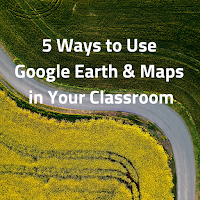
25 Aug Five Ideas for Using Google Earth & Maps for More Than Social Studies Lessons
Later this week I’m conducting an online professional development workshop about Google Earth and Maps. One of my goals for the workshop is to help participants develop ideas for using Google Earth and Google Maps for more than just geography and history lessons. To that end I’ve put together a short list of ideas and resources for using Google Earth and Google Maps in multiple subject areas.
Language Arts
Google Lit Trips is probably the most popular example of using Google Earth in the context of language arts. Google Lit Trips are Google Earth tours based on books and authors. In Google Earth and on Google’s My Maps services your students can create their own tours highlighting important places in a book or important places in the life of an author.
Science
Google Earth provides a great way for students to explore interesting geological landmarks in 3D. Using the timeslider in the desktop version of Google Earth can show students the changes in a landscape due to erosion and other natural and man-made forces.
There is no shortage of lesson plans featuring Google Earth available online. A couple that I recommend looking at are Rich Treves’ flooding and volcano lessons and What’s a Watershed created at the Science Education Resource Center at Carleton College.
Math
For K-5 classrooms there is probably no better place to start than on Tom Barrett’s Maths Maps site. There you will find short, Google Maps-based activities that require students to perform measurements and use arithmetic to answer questions. The activities represent a great combination of mathematics and geography.
If you have middle school or high school students, you will want to explore Real World Math. On Real World Math you will find lesson plans that utilize Google Earth for teaching the concepts used in calculating volume of solids, timezones, and rocketry.
Physical Education
Perhaps my favorite use of Google’s My Maps is for planning safe walking, hiking, and biking routes. You can also use Google Earth to help students understand how elevation change alters the speed at which routes are completed.
Art
By using Google’s My Maps tools or the desktop version of Google Earth, students can map the locations of where a piece of local art is housed, where it was created, and the places that inspired the artist. Each placemark on a student’s map could include a picture of the artwork, a picture of the artist, and or a video about the art and artist. To provide a complete picture a student can include text and links to more information about the art and artist.
For some inspiration on this topic take a look at Monet Was Here on Google Arts & Culture.Later this week I’m conducting an online professional development workshop about Google Earth and Maps. One of my goals for the workshop is to help participants develop ideas for using Google Earth and Google Maps for more than just geography and history lessons. To that end I’ve put together a short list of ideas and resources for using Google Earth and Google Maps in multiple subject areas.Language ArtsGoogle Lit Trips is probably the most popular example of using Google Earth in the context of language arts. Google Lit Trips are Google Earth tours based on books and authors. In Google Earth and on Google’s My Maps services your students can create their own tours highlighting important places in a book or important places in the life of an author.ScienceGoogle Earth provides a great way for students to explore interesting geological landmarks in 3D. Using the timeslider in the desktop version of Google Earth can show students the changes in a landscape due to erosion and other natural and man-made forces.There is no shortage of lesson plans featuring Google Earth available online. A couple that I recommend looking at are Rich Treves’ flooding and volcano lessons and What’s a Watershed created at the Science Education Resource Center at Carleton College.MathFor K-5 classrooms there is probably no better place to start than on Tom Barrett’s Maths Maps site. There you will find short, Google Maps-based activities that require students to perform measurements and use arithmetic to answer questions. The activities represent a great combination of mathematics and geography.If you have middle school or high school students, you will want to explore Real World Math. On Real World Math you will find lesson plans that utilize Google Earth for teaching the concepts used in calculating volume of solids, timezones, and rocketry. Physical EducationPerhaps my favorite use of Google’s My Maps is for planning safe walking, hiking, and biking routes. You can also use Google Earth to help students understand how elevation change alters the speed at which routes are completed.ArtBy using Google’s My Maps tools or the desktop version of Google Earth, students can map the locations of where a piece of local art is housed, where it was created, and the places that inspired the artist. Each placemark on a student’s map could include a picture of the artwork, a picture of the artist, and or a video about the art and artist. To provide a complete picture a student can include text and links to more information about the art and artist. For some inspiration on this topic take a look at Monet Was Here on Google Arts & Culture. Art, Free Technology For Teachers, Google Arts and Culture, Google Earth, google maps, Google My Maps, how to, Math, Mathematics, Maths, ScienceRead More
Art, Free Technology For Teachers, Google Arts and Culture, Google Earth, google maps, Google My Maps, how to, Math, Mathematics, Maths, ScienceRead More


Sorry, the comment form is closed at this time.